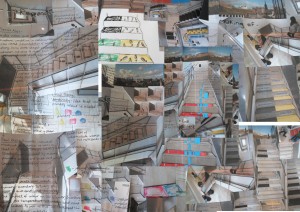Wednesday 26th February: So today was the day to get involved with a film! The film collaboration group were given pitches by the 4th year or masters graduate students. From this we could decide which production(s) we wanted to work for. Myself and Ruth Rae (another costume student) chose to work with Mario Cruzado, a 4th year student, who’s making a fiction film named ‘Ceremony’.
Thursday 27th February: This morning we met with Mario to discuss the ideas he had for costumes and what we need to supply before the film shooting (starting Mach 6th).
Mario told us that he was greatly inspired by Gregory Crewdson, who is a photographer. His works are very stylised, being very subdued and muted in colour scheme, lots of blues, browns and greens used to create surreal photos. Another aspect of his work which influenced Marios ideas was the use of natural light, the plan is for the only light in the film to be natural as to give quite a raw, earthy look, artificial light can look quite garish. He also showed us clips from ‘Spellbound’ and ‘Cries and Whispers’, which was really helpful to see examples of lighting and camera angles he is aiming for.
In the afternoon we were lucky enough to have a masterclass with actor Gary Lewis, these were some notes made during the talk:
He began by saying that he enjoys working on small budgeted films, as often they are more creative.
Motivation?- Joined a film society in secondary school, they watched ‘Kez’ by Ken Loach. It was the first production he seen were the character had a strong regional accent, he felt very passionate about this, being from Glasgow, wanted to create/be part of works including his own accent. ‘Making the local, universal’.
‘Nothing human is alien to me.’
He began his acting career working in theatres then went onto films.The relationship between the director and actor is really important, Lewis and Peter Mullens worked on a number of films together, they went through the lines and directions on location without any of the crew, before it was shot. Gives the two the opportunity to develop ideas, finalise directions see how actions and sound/voices fit together.
Assembling a good team is key! Everything needs to connect together, team needs to be in tune with each other. Positive attitudes contribute to a good atmosphere.
Costume really supports an actor, costume department need to have great attention to detail, adding really specific detail in order to contribute to the characters personality, showing their ambitions/fears/loves/likes/dislikes. When Lewis worked on Billy Elliot the costume designer sourced a scottish miners badge, Lewis’ character being scottish and having been a miner there previously to becoming a miner in Newcastle (the films setting), this gives the audience a little bit of a background story to the character. The audience find out and can possibly relate more to the character. Gives them some emotional background. Viewers will pity/feel happy for the character, you are emotionally involved. Minute detail is essential.
Actors must know the characters emotions/life journey because you may not film chronologically. For the purpose of location the most emotional scene may be filmed first.
Not only is being part of a team beneficial for the production but also because all members of the team read the script, each person will interprate the storyline differently, contributes to the discovery of new ideas and develop ideas for location/costume/props/acting style or way of saying a line.
It was really great listening to Garys experiences in the industry as well as informing us about the different roles included in the film crew and the importance of team work throughout!





























































